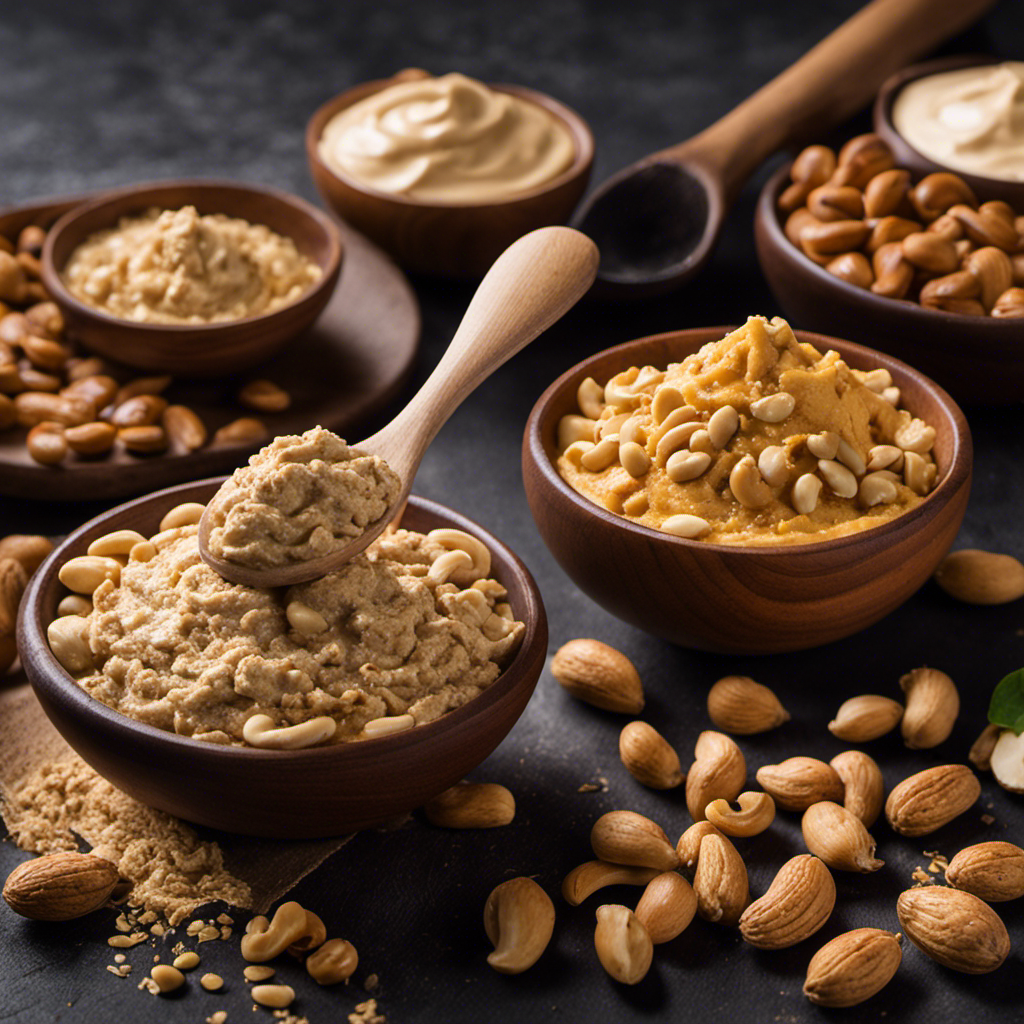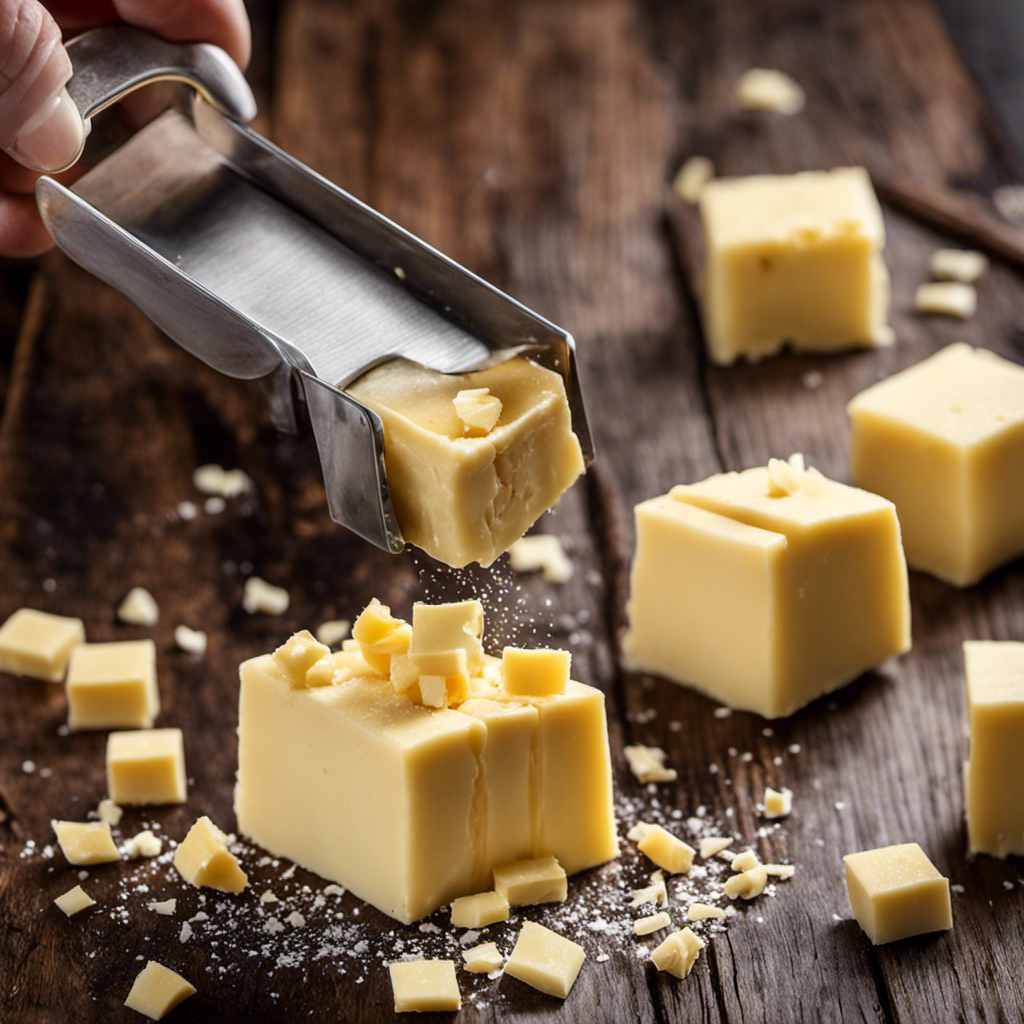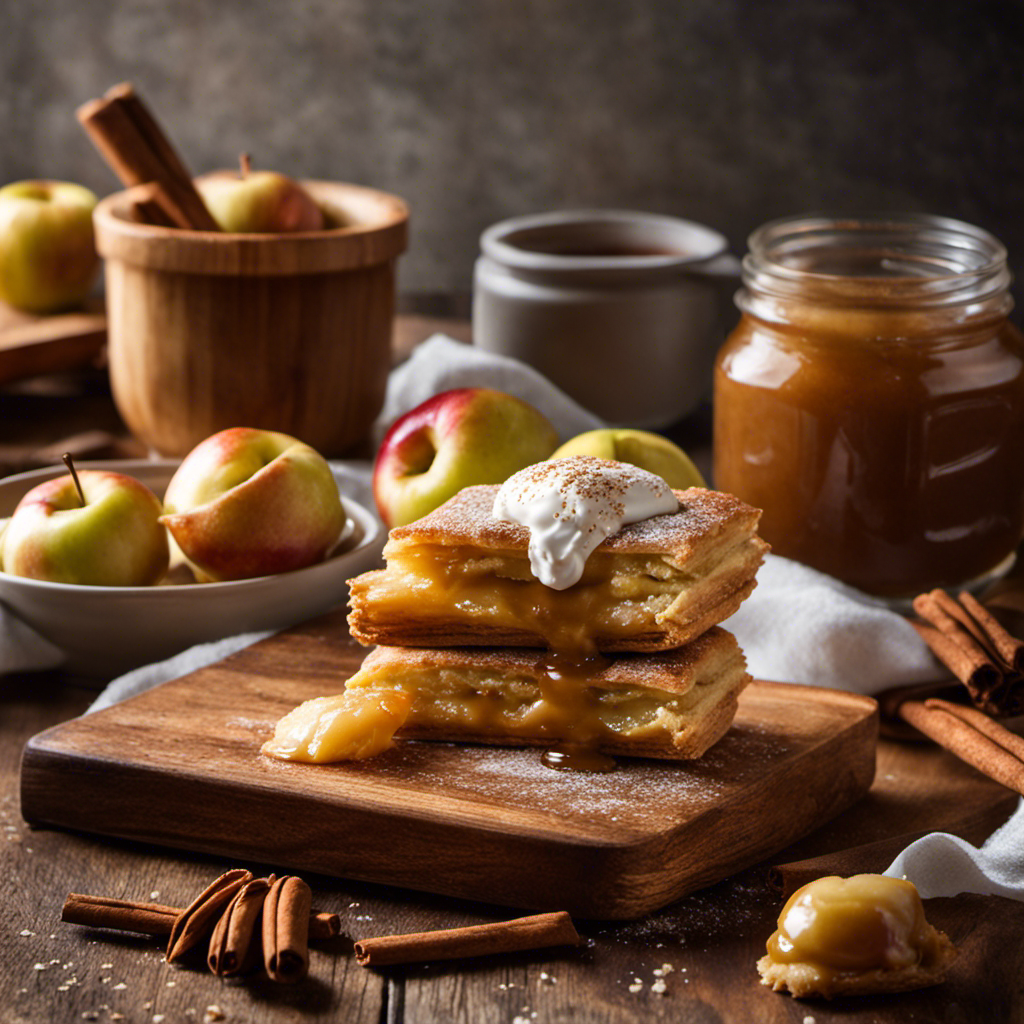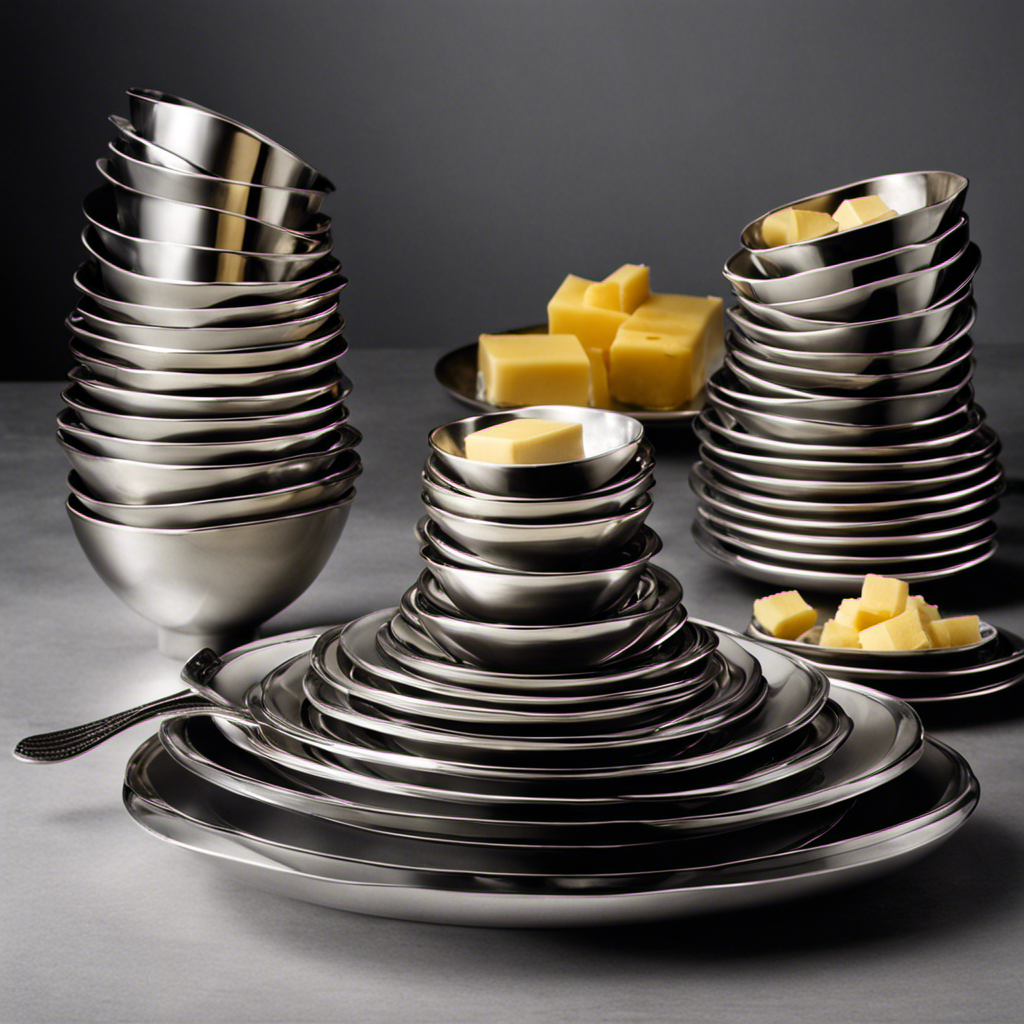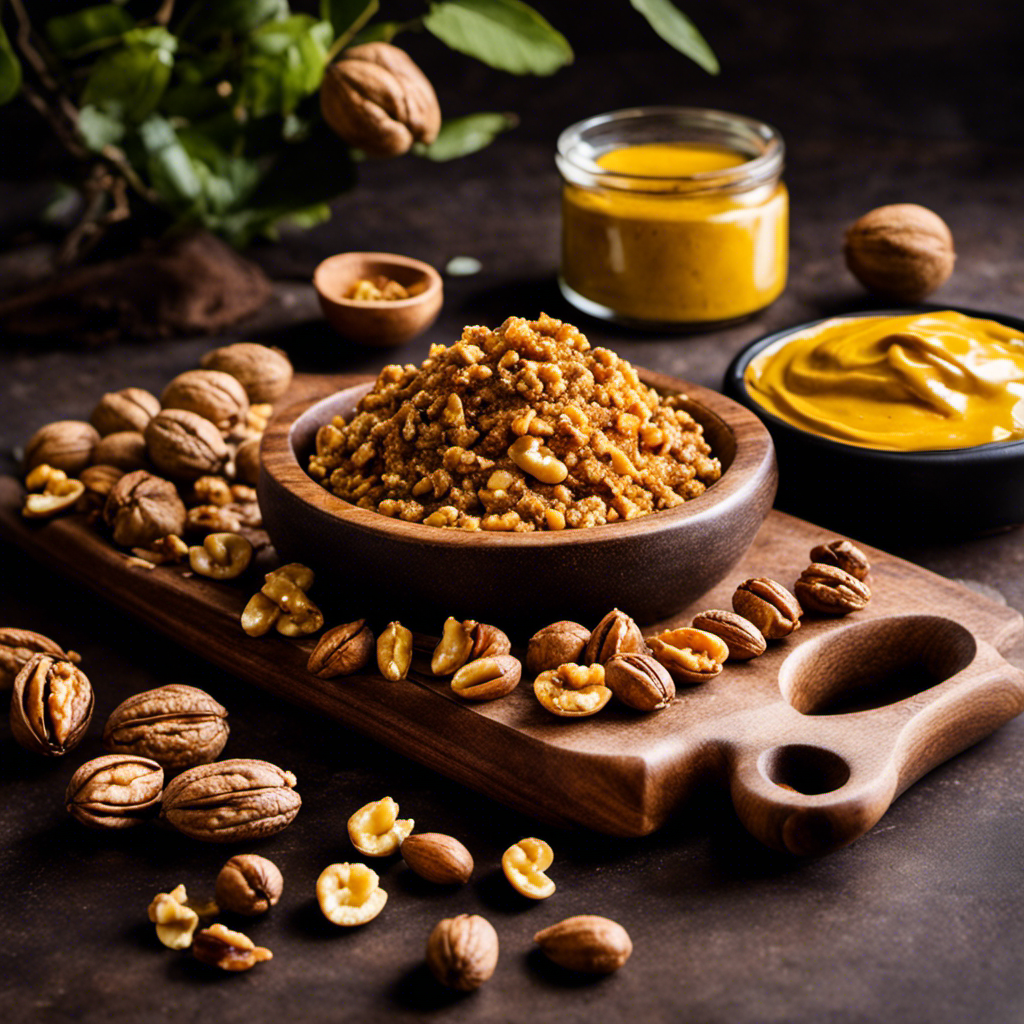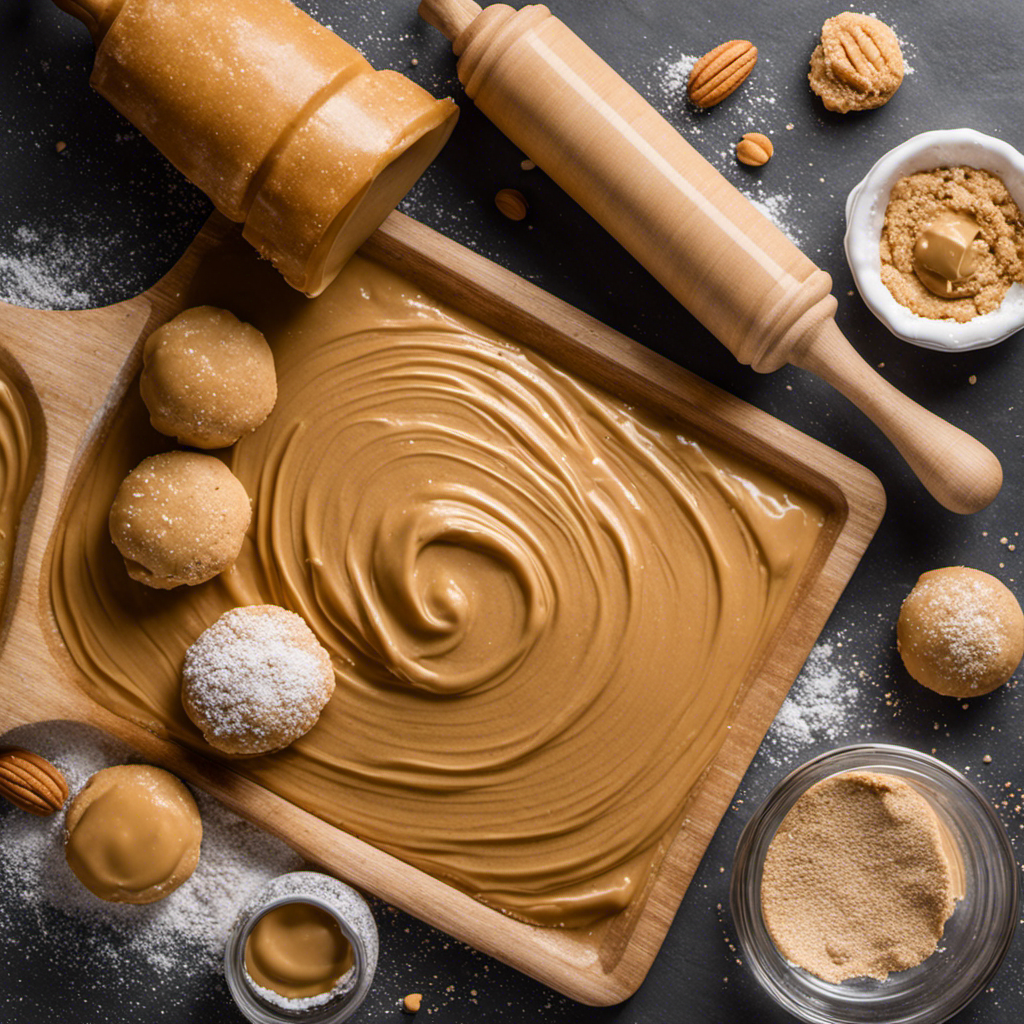As I dipped my spoon into the smooth, golden mixture, I couldn’t help but think of a decadent caramel swirl, filled with hints of toasted nuts.
Cashew butter, oh how you captivate my taste buds! With your sweet and nutty flavor, creamy smoothness, and delicate undertones, you are truly a decadent treat.
Join me on a mouthwatering journey as we explore the rich and buttery world of cashew butter and discover its versatile and delicious uses.
Key Takeaways
- Cashew butter has a sweet and nutty flavor.
- It adds a creamy and nutty element when paired with fruits.
- It adds a unique depth of flavor when used in savory dishes.
- Cashew butter has a velvety consistency that melts in your mouth.
Sweet and Nutty Flavor
Cashew butter has a sweet and nutty flavor that you’ll love. It’s a delicious spread that can be enjoyed in various ways.
The sweetness of cashew butter makes it a perfect ingredient for both sweet and savory combinations. When paired with fruits like apples or bananas, it adds a creamy and nutty element that enhances the overall taste. On the other hand, when used in savory dishes like stir-fries or sauces, it adds a unique depth of flavor that complements the other ingredients.
Besides its amazing taste, cashew butter also offers several health benefits. It is a good source of healthy fats, protein, and essential minerals like magnesium and copper. These nutrients support heart health, promote muscle growth, and aid in maintaining healthy bones.
Creamy and Smooth Texture
If you’ve ever had other nut butters, you’ll appreciate how creamy and smooth the texture of cashew butter is. It has a velvety consistency that melts in your mouth, making it a delight to spread on toast or use as a dip for fruits and vegetables. The natural oils in cashews contribute to its luxurious texture, giving it a rich and buttery feel.
But the appeal of cashew butter goes beyond its texture. It also offers a range of health benefits. Cashews are a good source of healthy fats, protein, and fiber, making cashew butter a nutritious addition to your diet. It is also packed with vitamins and minerals, including magnesium, phosphorus, and zinc. These nutrients support heart health, aid in digestion, and boost your immune system.
To further demonstrate the versatility of cashew butter, here is a table showcasing some savory applications and their benefits:
| Savory Application | Health Benefits |
|---|---|
| Cashew butter stir-fry sauce | Provides protein and healthy fats, enhances flavor |
| Cashew butter dressing | Adds creaminess and nutty taste, boosts nutrient intake |
| Cashew butter in soups | Thickens soup, adds richness, and provides essential nutrients |
Mild and Delicate Taste
When it comes to cashew butter, one of the first things that comes to mind is its nutty and creamy flavor. The combination of the rich, buttery taste of cashews with a subtle hint of sweetness creates a truly delightful experience for the palate.
Additionally, the versatility of cashew butter in culinary uses is truly impressive. From spreading it on toast to using it as a base for sauces and dressings, this creamy nut butter adds a unique and delicious twist to a variety of dishes.
Nutty and Creamy Flavor
You’ll love the nutty and creamy flavor of cashew butter. It has a rich and smooth taste that is both satisfying and delicious. The natural sweetness of the cashews shines through, giving it a unique and enjoyable flavor profile.
Cashew butter is a versatile ingredient that can be used in a variety of savory recipes, like stir-fries, sauces, and dips. Not only does it taste great, but it also offers several health benefits. Cashews are packed with nutrients, including healthy fats, protein, and vitamins. They can help support heart health, aid in weight management, and provide a good source of energy.
With its amazing taste and nutritional value, cashew butter is a fantastic addition to any kitchen. Now let’s explore its versatile culinary uses.
Versatile Culinary Uses
Cashew butter can be used in a variety of dishes, adding a nutty and creamy flavor that enhances the overall taste. Its versatility in culinary applications makes it a go-to ingredient for both sweet and savory recipes.
From spreading it on toast to using it as a base for dressings and sauces, cashew butter brings a unique richness to any dish. Not only does it add depth of flavor, but it also offers numerous health benefits.
Cashew butter is a great source of healthy fats, protein, and essential minerals like magnesium and zinc. It’s also naturally cholesterol-free and contains antioxidants.
With its rich and buttery notes, cashew butter adds a delightful touch to any recipe, elevating the taste to a whole new level.
Rich and Buttery Notes
If you’re looking for a creamy spread with rich and buttery notes, cashew butter is the perfect choice. Made from roasted cashews, it has a velvety texture and a distinct flavor that sets it apart from other nut butters.
Here are some reasons why you should try cashew butter:
-
Sweet and Savory Combinations: Cashew butter’s subtle sweetness makes it a versatile ingredient in both sweet and savory dishes. Spread it on toast with a drizzle of honey or use it as a base for sauces and dressings.
-
Health Benefits: Cashew butter is packed with nutrients like healthy fats, protein, and minerals like magnesium and zinc. It also contains antioxidants, which can help reduce inflammation and support overall health.
-
Creamy Texture: The smooth and creamy texture of cashew butter makes it a delightful addition to smoothies, oatmeal, or even as a dip for fruits and vegetables.
-
Weight Management: Despite its rich taste, cashew butter is lower in calories compared to other spreads like peanut butter. It can be a satisfying and nutritious option for those watching their calorie intake.
-
Nutritional Profile: Cashew butter is a good source of monounsaturated fats, which are heart-healthy fats that can help lower bad cholesterol levels. It also provides a good amount of fiber, which aids in digestion and promotes satiety.
Slightly Roasted Undertones
Cashew butter has a distinctive nutty flavor profile that adds depth and richness to any dish. It boasts a creamy and smooth texture that spreads effortlessly on toast or blends seamlessly into sauces and dressings.
As a versatile ingredient, cashew butter can be used in both sweet and savory recipes. From decadent desserts to flavorful curries, it is a staple in any kitchen.
Nutty Flavor Profile
You’ll love the nutty flavor profile of cashew butter. It’s a creamy and rich spread that is packed with deliciousness. Here are some reasons why cashew butter is a must-try:
-
Creamy texture: Cashew butter has a smooth and velvety texture that melts in your mouth.
-
Nutty taste: The flavor of cashew butter is distinctly nutty, with a hint of sweetness.
-
Salty undertones: There is a subtle saltiness that enhances the overall taste of cashew butter.
-
Versatile ingredient: Cashew butter can be used in a variety of recipes, from smoothies to baked goods.
-
Savory pairing options: Cashew butter pairs well with savory ingredients like garlic, soy sauce, and spices, making it a great addition to sauces and dressings.
With its nutty taste, creamy texture, and savory pairing options, cashew butter is a versatile and delicious ingredient that can elevate any dish.
Creamy and Smooth
Indulge in the velvety smoothness of this creamy spread that will take your taste buds on a delightful journey. Cashew butter, with its rich and luxurious texture, is a delicious spread that offers a myriad of health benefits.
Made from roasted cashews, this creamy delight is not only a tasty addition to your pantry, but it also packs a nutritional punch. Cashew butter is a great source of healthy fats, protein, and fiber, making it a nutritious choice for your snacks or meals.
It is also loaded with vitamins and minerals, including magnesium, phosphorus, and zinc. These nutrients contribute to overall health, supporting bone strength, boosting immunity, and promoting heart health.
Versatile Ingredient Options
When it comes to adding flavor and variety to your dishes, cashew butter offers a wide range of versatile ingredient options. This creamy and smooth spread is not only delicious on its own, but it can also be used in a variety of healthy recipes and as an alternative to other spreads.
Here are some ways you can incorporate cashew butter into your cooking:
- Spread it on toast or crackers for a quick and satisfying snack.
- Use it as a base for sauces and dressings to add a rich and creamy texture.
- Blend it into smoothies for added creaminess and a nutty flavor.
- Add it to baked goods like cookies and brownies for a nutty twist.
- Use it as a topping for oatmeal or yogurt for added flavor and protein.
With its versatility and health benefits, cashew butter is a great addition to any kitchen pantry.
Natural and Earthy Aroma
If you’re a fan of natural and earthy flavors, cashew butter will delight your taste buds with its distinct aroma. The earthy scent of cashew butter is reminiscent of freshly roasted cashews, filling the air with its nutty fragrance.
As you open the jar, the natural flavor of cashew butter greets you, promising a rich and creamy experience. The smooth texture and velvety consistency make it easy to spread on toast or use as a dip for fruits and vegetables.
The earthy undertones add depth to its flavor profile, making it a versatile ingredient in both sweet and savory dishes. Whether you’re incorporating it into your morning smoothie or using it as a base for a sauce, cashew butter’s natural and earthy aroma will elevate your culinary creations.
Versatile and Delicious Uses
Try experimenting with cashew butter in both sweet and savory dishes to discover its versatility and deliciousness. Cashew butter can add a unique and creamy flavor to a variety of recipes, making it a great substitute for traditional nut butters. Here are some ideas to get you started:
- Spread cashew butter on toast or bagels for a delicious and nutritious breakfast option.
- Use cashew butter as a base for homemade salad dressings or sauces to add a rich and creamy texture.
- Incorporate cashew butter into smoothies or protein shakes for an extra boost of protein and healthy fats.
- Add cashew butter to baked goods like cookies or brownies for a nutty and indulgent twist.
- Use cashew butter as a dip for fresh fruit or vegetables for a healthy and satisfying snack.
Not only is cashew butter delicious, but it also offers several health benefits. It’s a good source of healthy fats, protein, and fiber, which can help keep you feeling fuller for longer and support overall digestive health. Additionally, cashew butter is rich in vitamins and minerals, such as magnesium, phosphorus, and zinc, which are important for maintaining optimal bodily functions.
Frequently Asked Questions
How Is Cashew Butter Different From Other Nut Butters in Terms of Taste and Texture?
Cashew butter has a distinct flavor and creamy consistency that sets it apart from other nut butters. Its taste is rich and slightly sweet, while its texture is smooth and velvety.
Can Cashew Butter Be Used as a Replacement for Other Spreads Like Peanut Butter or Almond Butter?
Cashew butter can definitely be used as a replacement for spreads like peanut butter or almond butter. It has a unique creamy texture and a slightly sweet, nutty taste that adds a delicious flavor to both sweet and savory dishes.
Are There Any Health Benefits Associated With Consuming Cashew Butter?
Consuming cashew butter has several health benefits. It can aid in weight loss due to its high protein and fiber content. Additionally, it promotes heart health by providing healthy fats and reducing bad cholesterol levels.
How Can Cashew Butter Be Incorporated Into Savory Dishes and Recipes?
Incorporating cashew butter into savory dishes and recipes offers a world of flavor pairings and creative uses. It adds a creamy richness and subtle nuttiness that enhances everything from dressings to stir-fries.
Are There Any Potential Allergens or Common Side Effects Related to Consuming Cashew Butter?
I’ve heard some people may experience potential allergic reactions or digestive issues when consuming cashew butter. It’s important to be aware of these possible side effects before incorporating it into your diet.
Conclusion
In conclusion, cashew butter is a delectable spread that offers a unique taste experience. With its sweet and nutty flavor, creamy texture, and delicate taste, it is sure to please the palate.
What’s interesting is that cashew butter is not only delicious but also nutritious. It is packed with healthy fats, vitamins, and minerals. In fact, a study found that consuming nuts, including cashews, can reduce the risk of heart disease by up to 30%.
So not only does cashew butter taste amazing, but it also provides health benefits.
